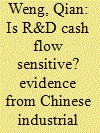| Srl | Item |
| 1 |
ID:
138104


|
|
|
|
|
| Summary/Abstract |
This paper uses a panel data-fixed effect approach and data collected from Chinese public manufacturing firms between 1999 and 2011 to investigate the impacts of business life cycle stages on capital structure. We find that cash flow patterns capture more information on business life cycle stages than firm age and have a stronger impact on capital structure decision-making. We also find that the adjustment speed of capital structure varies significantly across life cycle stages and that non-sequential transitions over life cycle stages play an important role in the determination of capital structure. Our study indicates that it is important for policy-makers to ensure that products and financial markets are well-balanced.
|
|
|
|
|
|
|
|
|
|
|
|
|
|
|
|
| 2 |
ID:
099511


|
|
|
|
|
| Publication |
2010.
|
| Summary/Abstract |
The following article examines how the principles of coercion theory can be applied towards the formulation of strategy aimed at countering terrorist financing. In doing so, this article provides a breakdown of coercion's relevant theoretical concepts on the subject matter. This is followed by an elaboration of the specific coercive approaches-non-military and military-that can be implemented to counter terrorist finance operations, along with an illustration, based on case-evidence, of how these approaches can be practically employed with power and policy mechanisms at the state and international levels. The article concludes with a discussion on what is required, from a coercion stand-point, to successfully counter a terrorist organization's financial operations, as well as the advantages and limitations involved in such a strategy.
|
|
|
|
|
|
|
|
|
|
|
|
|
|
|
|
| 3 |
ID:
161769


|
|
|
|
|
| Summary/Abstract |
We hypothesize that research and development (R&D) is sensitive to cash flow fluctuations due to asymmetric information and agency problems in the credit market. We adopt a variant of the Q model for R&D investment using the value of the firm, physical capital and employment to capture firm fundamentals as proxies for investment opportunities. We add cash flow to this specification, and estimate the augmented model separately for R&D participation and spending decisions using data on Chinese industrial firms for the period 2001–2006. We find that R&D participation and spending are sensitive to cash flow fluctuations, conditional on firm fundamentals. We also find that the cash flow sensitivity of R&D varies across firms depending on ownership.
|
|
|
|
|
|
|
|
|
|
|
|
|
|
|
|